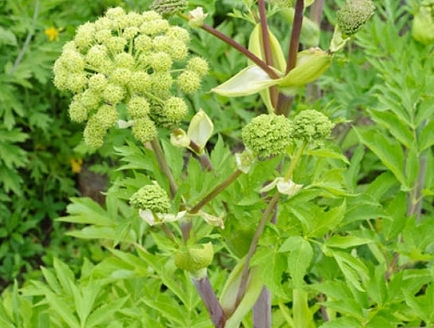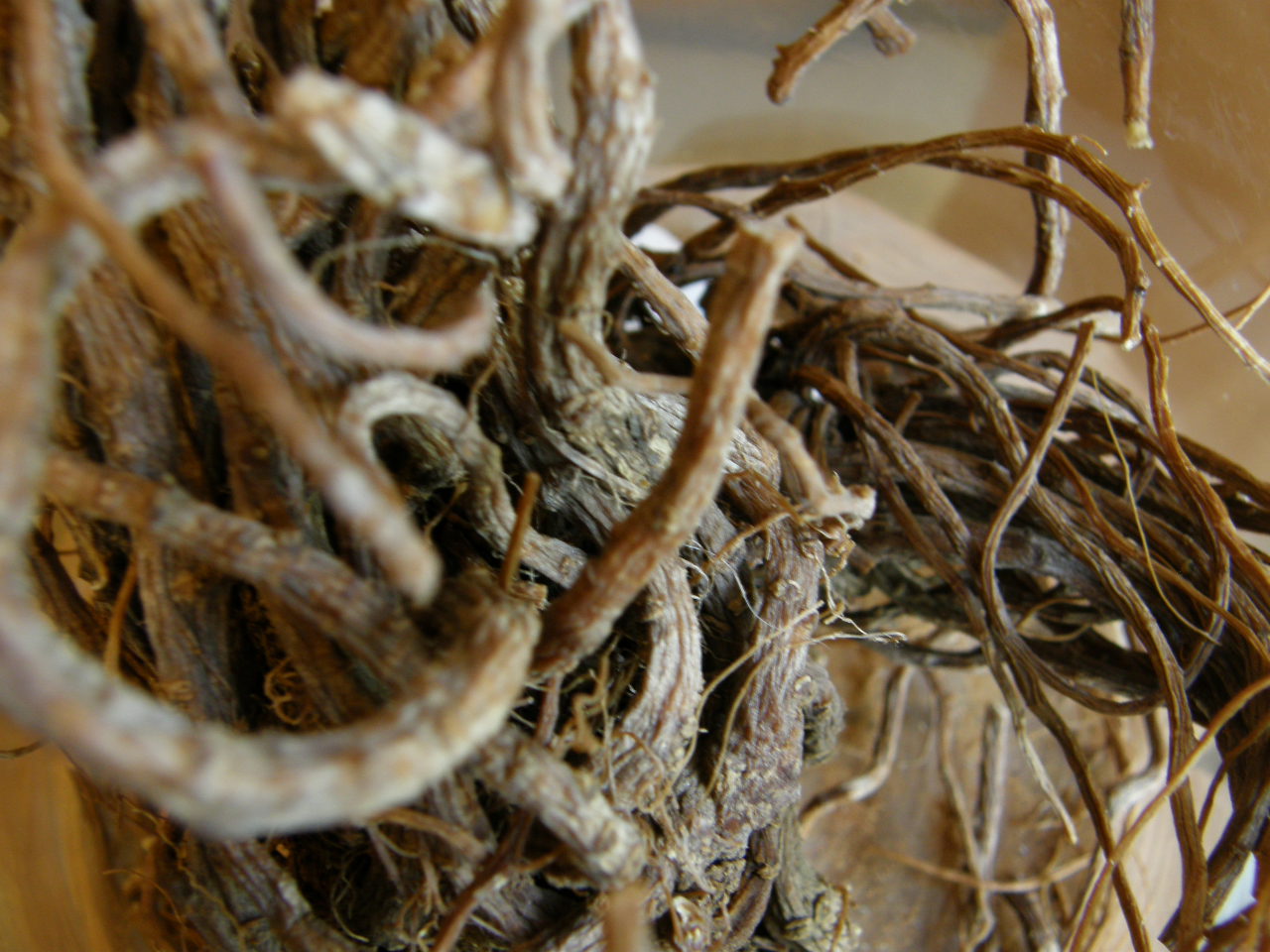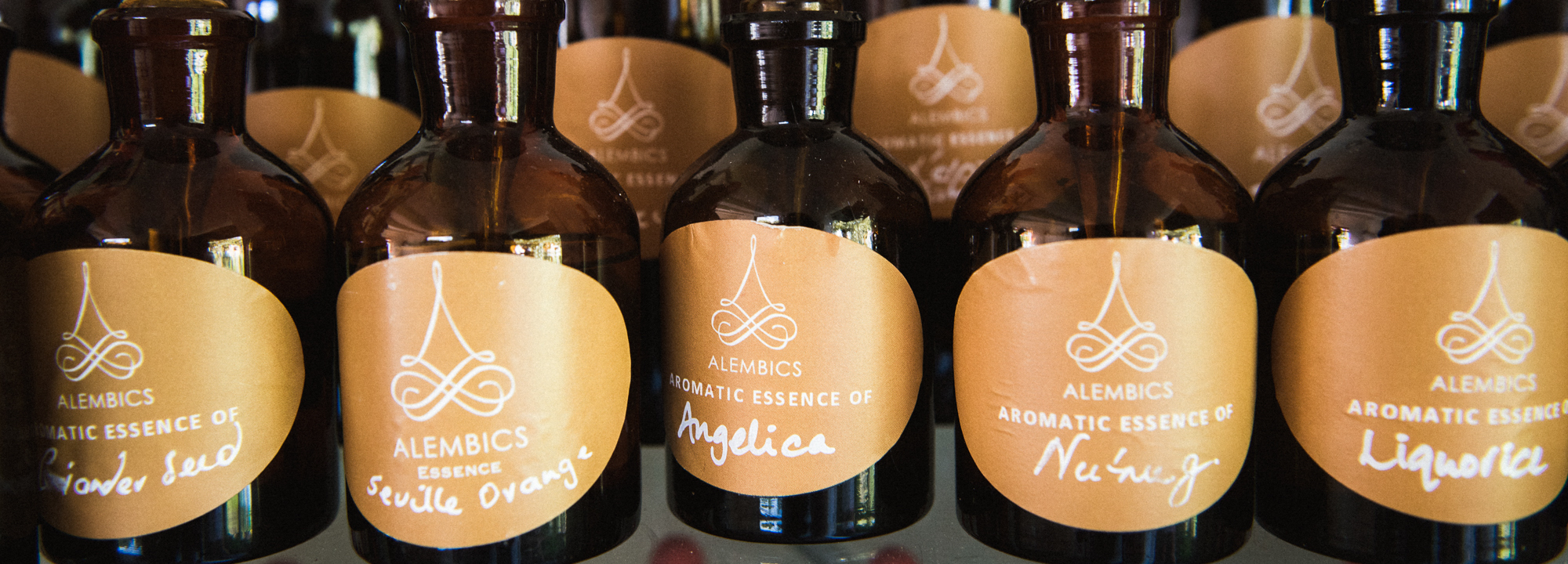Angelica archangelica
ENCYCLOPEDIA BOTANICA / ANGELICA
All parts of angelica are fragrant, from the root to the crown. Each part of the plant has slightly different properties—and many aromatic uses. Its flavour and aroma spans from deep, earthy, spicy tones, to bright green, fresh sweet notes.
Description & Habitat
Angelica archangelica is arguably one of the most beautiful of botanical names. It is also known as ‘wild celery’ and ‘Norwegian angelica’. There are around 60 different species of angelica, and other species are also used as flavouring agents or in herbalism (like traditional Chinese medicine) so it pays to do your research and ensure correct identification. Angelica archangelica was popular in the middle ages for its therapeutic and ritual virtues—you can find it recorded and praised throughout common European folklore as the ‘medicine of angels’. Angelica is a perennial, herbaceous plant with bold and attractive foliage—the leaves and stalks are reddish-purple and bright green in colour—and its yellow flowers are petite but numerous and grouped in round umbels, like delicate parasols. The plant can soar up to six feet tall, arching high over the other plants in the garden.
Parts used: Root, stems, leaves, flowers and seeds.

Angelica archangelica

Dried angelica root
Growth and harvesting: Angelica is described as a biennial—which means it flowers in its second year of growth—though we find it often takes three years to flower and set seeds in our garden on Waiheke Island. Like other members of the Apiaceae (carrot) family, it has a long, tapering taproot that is established in the first year of growth. To harvest angelica root, it’s best to dig it up in the autumn of this first year (on the waning moon, if you’re feeling poetic). At this stage, it will come up as white as alabaster and fragrant as an angel. Wash it well, slice while fresh, and dry in a warm place protected from insects. If using the root fresh, grate and use immediately, before oxidation starts to degrade that fresh nature.
It is useful to leave some plants to flower and set seed in that second year, to continue your crop. If you were to dig up the root of these older plants, you’re likely to find that the bugs have set in, and it’s lost that clean, strong, angelic quality of your first year harvest. That’s because this second half of the life-cycle is where the plant directs its energy into reproduction—the volatile organic compounds behind its chemical signals and protections are all geared towards the flowers and seeds, and not the root.
Aroma & Flavour Profile
In its raw dried state, angelica root has a vibrant, refreshing and unmistakably green celery-like flavour. Distilled angelica root has a delicious earthy flavour with a pleasing bitterness, and strong woody-herbaceous quality, some describe as similar to wormwood. Herbal tones carry through to the nose, imparting a soft, grassy aroma.
Because angelica is often the third major ingredient in gin recipes (following juniper and coriander seeds) some people find it hard to untwine the flavour and aroma from the piney juniper, but it’s quite distinct, and why it’s a good reason to taste the botanical on its own.

Recommended techniques
• Hydro distillation • Steam distillation (EO) • spirit distilling (gin/liqueurs) • Tincture • CO2 extraction •
Uses
Spirits
Angelica root is used to infuse many liquors—most famously vermouth—but also Bénédictine, Chartreuse and absinthe. It’s a classic botanical in gin, considered by many to be the third major botanical ingredient after juniper and coriander. In a gin recipe angelica adds character to the nose, and being a root with fixative properties, also enhances the finish. Like other dried roots, angelica imparts an earthiness (or woodiness), and weight that assists with structure. It has a pervasive aroma so when using it in blends less is better than more as it will override other more delicate notes. While angelica’s long, tendril-like roots that are classically distilled and added to gin, the flowers and seeds can also be used. These add more green, celery notes.
Culinary
The stems are hollow and coated on the inside with a fragrant, creamy white sap. Stems have an intense fresh, sharp and pervasive note, while the leaves are less pervasive and have an additional vegetal character. Both are best harvested fresh when the plant is young. They can be candied, and used for infusing flavour and as an aromatic garnish. The seeds are often crushed and used as a flavour enhancer on both food and spirits.
Hydrosol
Makes a richly aromatic hydrosol with a soapy, cosmetic character. The hydrosol is intense, and has a bitter taste. It works well blended with other hydrosols for both botanical spirits and cosmetic preparations.
Essential Oil
All parts of the plant can be used to produce essential oil, the plant material, seeds and roots. Angelica essential oil has a history of use in aromatherapy, mostly for combating stress and anxiety.
Perfumery
For perfumery, both CO2 extraction of angelica root, and angelica essential oil are widely-used. Our preference (and one of our favourites) is the angelica CO2. It’s strong and rich with an intriguing combination of floral, earth and musk. Sometimes angelica can be the main note in a perfume, but more often it’s used to add depth and complexity to blends. It can add a green touch and soften sharp citrus notes, but depending on what it’s combined with it can add sweetness, spice, woodiness or florality. It’s very versatile. As in gin it’s also used as a fixative or synergist (what a great term!) meaning it brings and holds a scent together. Famous commercial examples are Jo Malone’s Rain and Angelica, Angélique Noir by Guerlain and Creed’s Royal Oud.
Tincture
Angelica root has been tinctured and used for herbal medicine preparations for centuries. The tincture tastes intensely astringent with all the tannins that the alcohol extracts. But if you were to run this tincture through your still (turning it into what we call a quintessence) that distilled tincture becomes much more ethereal, with all the beautiful earthy and herbaceous notes that angelica is famous for. And it’s a great approximation of what flavour notes will come through in your gin-making, which is why we use quintessences to teach us how to blend in our Gin Immersion course.


